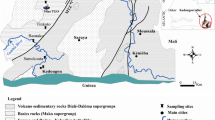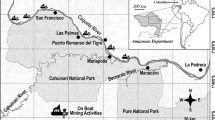Abstract
Mercury (Hg) contamination is an issue of concern in the Amazon region due to potential health effects associated with Hg exposure in artisanal gold mining areas. The study presents a human health risk assessment associated with Hg vapor inhalation and MeHg-contaminated fish ingestion, as well as Hg determination in urine, blood, and hair, of human populations (about 325 miners and 321 non-miners) from two gold mining areas in the Brazilian Amazon (São Chico and Creporizinho, Pará State). In São Chico and Creporizinho, 73 fish specimens of 13 freshwater species, and 161 specimens of 11 species, were collected for total Hg determination, respectively. The hazard quotient (HQ) is a risk indicator which defines the ratio of the exposure level and the toxicological reference dose and was applied to determine the threat of MeHg exposure. The mean Hg concentrations in fish from São Chico and Creporizinho were 0.83 ± 0.43 and 0.36 ± 0.33 μg/g, respectively. More than 60 and 22 % of fish collected in São Chico and Creporizinho, respectively, were above the Hg limit (0.5 μg/g) recommended by WHO for human consumption. For all sampling sites, HQ resulted from 1.5 to 28.5, except for the reference area. In Creporizinho, the values of HQ are close to 2 for most sites, whereas in São Chico, there is a hot spot of MeHg contamination in fish (A2—São Chico Reservoir) with the highest risk level (HQ = 28) associated with its human consumption. Mean Hg concentrations in urine, blood, and hair samples indicated that the miners group (in São Chico: urine = 17.37 μg/L; blood = 27.74 μg/L; hair = 4.50 μg/g and in Creporizinho: urine = 13.75 μg/L; blood = 25.23 μg/L; hair: 4.58 μg/g) was more exposed to mercury compared to non-miners (in São Chico: urine = 5.73 μg/L; blood = 16.50 μg/L; hair = 3.16 μg/g and in Creporizinho: urine = 3.91 μg/L; blood = 21.04 μg/L, hair = 1.88 μg/g). These high Hg levels (found not only in miners but also in non-miners who live near the mining areas) are likely to be related to a potential hazard due to exposure to both Hg vapor by inhalation and to MeHg-contaminated fish ingestion.
Similar content being viewed by others
References
Akagi H (1998) Studies on mercury pollution in the Amazon, Brazil. Glob Environ Res 2:193–202
Akagi H, Nishimura H (1991) Speciation of mercury in the environment toxicology. In: Suzuki T, Imura N (eds) Advances in Mercury. Plenum Press, New York, pp 53–76
Akagi H, Kinjo Y, Branches F, Malm O, Harada M, Pfeiffer WC, Kato H (1994) Methylmercury pollution in Tapajos river basin, Amazon. Environ Sci 3:25–32
Bell ZG, Lovejoy HB, Vizena TR (1973) Mercury exposure evaluations and their correlation with urine mercury excretions. 3. Time-weighted average (TWA) mercury exposures and urine mercury levels. J Occup Med 15(6):501–508
Bidone ED, Castilhos ZC, Cid de Souza TM, Lacerda DL (1997) Fish contamination and human exposure to mercury in the Tapajós River Basin, Pará State, Amazon, Brazil: a screening approach. Bull Environ Cont Toxicol 59:194–201. doi:10.1007/978-94-011-3975-5_2
Bruggeman WA (1982) Hidrophobic interactions in the aquatic environment. In: Hutzinger O (ed) The handbook of environmental chemistry, vol 2. Spring-Verlag, Germany, p 205
Castilhos ZC, Bidone ED, Lacerda LD (1998) Increase of the reference human exposure to mercury through fish consumption due to gold mining at the Tapajos river region, Amazon. Bull Environ Cont Toxicol 6:202–209. doi:10.1007/s001289900749
Castilhos ZC, Rodrigues-Filho S, Rodrigues APC, Viilas-Bôas RCV, Siegel S, Veiga M, Beinhoff C (2004) Mercury contamination in fish from gold mining areas in the Brazilian Amazon and human health risk assessment. In: 7th International Conference on Mercury as a Global Pollutant, Book of Abstracts (CD-Room), Ljubliana (Eslovênia)
Castilhos ZC, Rodrigues-Filho S, Rodrigues APC, Viilas-Bôas RCV, Siegel S, Veiga M, Beinhoff C (2006) Mercury contamination in fish from gold mining areas in Indonesia and human health risk assessment. Sci Total Environ 368:320–325. doi:10.1016/j.scitotenv.2006.01.039
Cesar RG, Egler S, Polivanov H, Castilhos Z, Rodrigues AP (2011) Mercury, copper and zinc contamination in soils and fluvial sediments from an abandoned gold mining area in southern Minas Gerais State, Brazil. Environ Earth Sci 64:211–222
Correia J, Cesar RG, Marsico E, Diniz GTN, Zorro MC, Castilhos ZC (2014) Mercury contamination in alligators (Melanosuchus niger) from Mamirauá Reservoir (Brazilian Amazon) and human health risk assessment. Environ Sci Poll Res 21:13522–13527. doi:10.1007/s11356-014-3282-0
Engström K, Ameer S, Bernaudat L, Drasch G, Baeuml J, Bose-O’Reilly S, Broberg K (2013) Polymorphisms in genes encoding potential mercury transporters and urine mercury concentrations in populations exposed to mercury vapor from gold mining. Environ Health Perspect 121(1):85–91. doi:10.1289/ehp.1204951
Freire C, Ramos R, Lopez-Espinosa MJ, Díez S, Vioque J, Ballester F, Fernández MF (2010) Hair mercury levels, fish consumption, and cognitive development in preschool children from Granada, Spain. Environ Res 110(1):96–104. doi:10.1016/j.envres.2009.10.005
Hacon S, Yokoo E, Valente J, Campos RC, Silva VA, Menezes ACC (2000) Exposure to mercury in pregnant women from Alta Floresta—Amazon Basin, Brazil. Environ Res 84(3):204–210. doi:10.1006/enrs.2000.4115
Harari R, Harari F, Gerhardsson L, Lundh T, Skerfving S, Strömberg U, Broberg K (2012) Exposure and toxic effects of elemental mercury in gold-mining activities in Ecuador. Toxicol Lett 213(1):75–82. doi:10.1016/j.toxlet.2011.09.006
Krenkel P (1971) Report on international conference on environmental mercury contamination. Water Res 5:1121–1122
Rodrigues-Filho S, Maddock JEL (1997) Mercury pollution in two gold mining areas of the Brazilian Amazon. J Geoch Expl 58:231–240
Rodrigues-Filho S, Castilhos, ZC, Santos RLC, Yallouz AV, Nascimento FMF, Egler SG (2004) Environmental and health assessment in two small scale gold mining areas—Indonesia—Sulawesi and Kalimantan. CETEM's Technical Final Report to UNIDO-Reserved. 211 pp
Santos EOS, Jesus IM, Brabo ES, Loureiro ECB, Mascarenhas AFS, Weirich J, Câmara VM, Cleary D (2000) Mercury exposures in riverside Amazon communities in Pará, Brazil. Environ Res 84(2):100–107. doi:10.1006/enrs.2000.4088
Schulz C, Angerer J, Ewers U, Kolossa-Ghering M (2007) The German Human Biomonitoring Commission. Int J Hyg Environ Health 210:373–382
Skerfving S (1973) Mercury in fish—some ecological considerations. Food Cosmet Toxicol 10:543–556
Slot C (1965) Plasma creatinine determination. A new and specific Jaffe reaction method. Scand J Clin Lab Inv 17:381–387
Steckling N, Boese-O'Reilly S, Gradel C, Gutschmidt K, Shinee E, Altangerel E, Badrakh B, Bonduush I, Surenjav U, Roider R, Sakamoto M, Sepai O, Drasch G, Lettmeier B, Morton J, Jones K, Siebert U, Hornberg C (2011) Mercury exposure in female artisanal small-scale gold miners (ASGM) in Mongolia: an analysis of human biomonitoring (HBM) data from 2008. Sci Total Environ 409(5):994–1000. doi:10.1016/j.scitotenv.2010.11.029
Tsuji JS, Williams PRD, Edwards MR, Allamneni KP, Kelsh MA, Paustenbach DJ, Sheehan PJ (2003) Evaluation of mercury in urine as an indicator of exposure to low levels of mercury vapor. Environ Health Perspect 111(4):623–630. doi:10.1289/ehp.5717
Ullrich SM, Tanton TW, Abdrashitova SA (2001) Mercury in the aquatic environment: a review of factors affecting methylation. Crit Rev Environ Sci Technol 31(3):241–293
U.S.EPA - United States Environmental Protection Agency (1989) United States Environmental Protection Agency: risk assessment guidance for Superfund. Vol I: human health evaluation Manual, Washington DC
US EPA - United States Environmental Protection Agency. (2014). IRIS—Integrated Risk Information System. http://www.usepa.gov/iris. Accessed 10 May 2014
WHO – World Health Organization (1990) Environmental health criteria 101: methylmercury. World Health Organization, Geneva
WHO – World Health Organization (1991) Environmental health criteria 118. Inorganic mercury. International Program on Chemical Safety. World Health Organization, Geneva
Yagev Y (2002). Eating fish during pregnancy: risk of exposure to toxic levels of methylmercury. http://www.motherisk.org/prof/updatesDetail.jsp?content_id=934. Accessed 10 May 2014
Acknowledgments
We acknowledge the fishermen Mr. Leandro, Mr. Jararaca, and Mr. Irmão Chagas, who kindly helped us to collect all of these Amazonian fish. This study was supported by UNIDO.
Author information
Authors and Affiliations
Corresponding author
Additional information
Responsible editor: Philippe Garrigues
Rights and permissions
About this article
Cite this article
Castilhos, Z., Rodrigues-Filho, S., Cesar, R. et al. Human exposure and risk assessment associated with mercury contamination in artisanal gold mining areas in the Brazilian Amazon. Environ Sci Pollut Res 22, 11255–11264 (2015). https://doi.org/10.1007/s11356-015-4340-y
Received:
Accepted:
Published:
Issue Date:
DOI: https://doi.org/10.1007/s11356-015-4340-y




